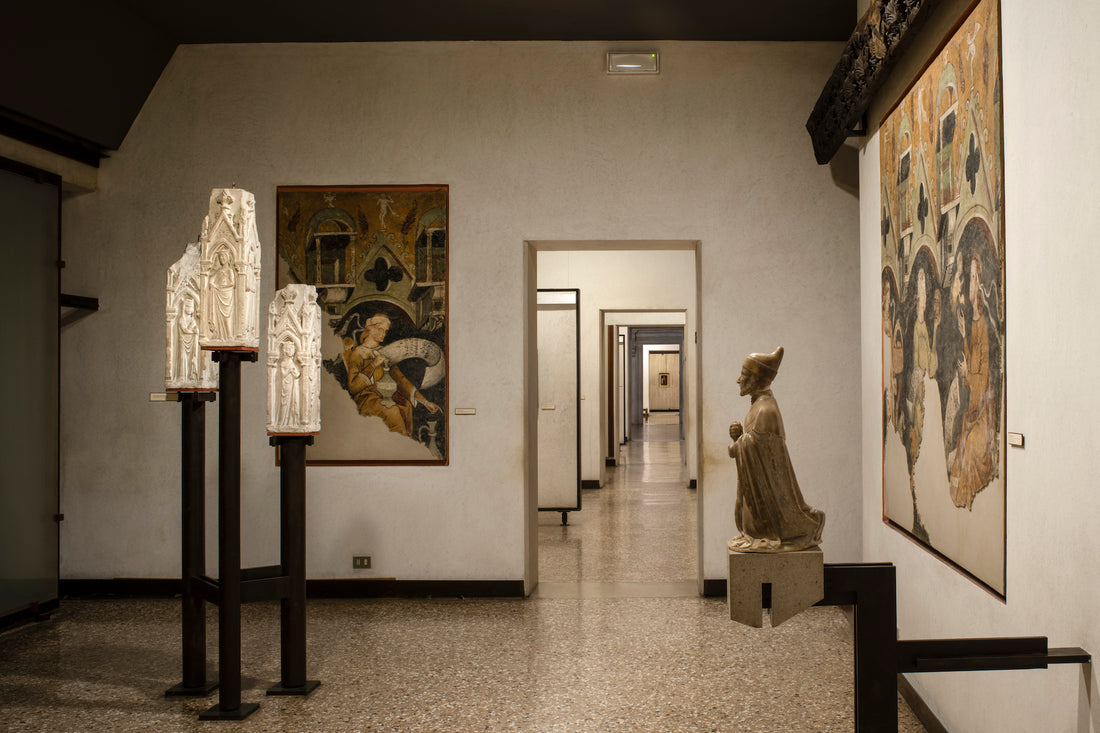
A walking tour of Carlo Scarpa architecture in Venice
Share
Are you a Modern architecture lover visiting Venice on holiday? This tour of buildings designed by Venice-born Italian architect Carlo Scarpa (1906 – 1978) is your ideal afternoon activity. Your guide is professor Marco Mulazzani, author of our Modern Venice Map / Mappa di Venezia Moderna. Read on and you will discover how Scarpa’s work is very unique to the city of Venice and notable for its crafted details and modern approach – plus some espresso spots and bookshops along the way.

Carlo Scarpa's Sculpture Garden (1950-52) at the Giardini della Biennale. Photography: Alessandra Chemollo
Let’s start at the Giardini della Biennale, the site of Venice’s globally renowned Biennale Art Exhibition since its very first edition in 1895, which was built by Napoleon in the early 19th century and later peppered with 29 national architectural pavilions from 1907. You can get there from Piazzale Roma or from the Railway station by taking the vaporetto (line 1) along the Grand Canal.
If you’re feeling ambitious, on this route, you can make a stop at Accademia to visit the Gallerie dell’Accademia (Campo della Carità, Dorsoduro 1050), a museum of Venetian paintings housed in the historic complex of Santa Maria della Carità. Within the buildings, there are still several rooms set up by Carlo Scarpa (designed 1945-60) and the most recent restoration work at the site was undertaken by Tobia Scarpa, son of Carlo Scarpa (2005-13).

Gallerie dell’Accademia. Photography: Alessandra Chemollo
Arriving at the Biennale Gardens, at the end of the avenue is the Entrance ticket Kiosk designed by Scarpa (1950-52), no longer used but fortunately preserved in good condition. Once inside, along the avenue to the left is the Venezuela Pavilion (1953-56), which still exists and can be visited, but has been awaiting complete restoration for many years. In the Central Pavilion, on the other hand, is the Sculpture Garden (1950-52), a marvellous little patio created to house a few selected works of sculpture.
Of course, in the Giardini there are other small great masterpieces of architecture, such as the pavilions of Austria (Josef Hoffman), Finland (Alvar Aalto), Holland (Gerrit Rietvel), Canada (BBPR Group), the Nordic Countries (Sverre Fehn)... but for this you have the Modern Venice Map with you, or you can find a small publication that tells about them all (Marco Mulazzani, Guide to the Pavilions of the Venice Biennale since 1887).
Leaving the Giardini, walk back towards San Marco Square. Along the Riva dei Sette Martiri you will find a little-known work by Scarpa, the Monument to the Venetian Partisan Woman (1968). The monument comprises a sculpture of a bronze woman by Augusto Murer with a metal, concrete and bronze base by Scarpa and celebrates the women who contributed to the end of fascism in Italy.
Before (or after) you can stop at Caffè La Serra (via Giuseppe Garibaldi 1254), a 19th-century iron-and-glass greenhouse transformed (well) into a place to eat or drink.

Olivetti Store (1957-58). Photography: Alessandra Chemollo
Finally arriving in San Marco Square, after admiring the great Basin, Palladio’s churches, the Ponte dei Sospiri and the Doge’s Palace, you can visit two important works by Scarpa. Firstly, the Olivetti Store (1957-58), a former retail shop for the design brand, which was restored several years ago and is now under the management of the FAI (Italian Environment Fund). On the opposite side of the Piazza, on the second floor of the Correr Museum – which explores the history of Venice – is the Picture Gallery (1957-60) maintained to Scarpa’s original layout.
After (or before) these visits, it is worth going in for an espresso at the counter at Caffè Florian or seated (for the Alajmo’s restaurant it is best to make a reservation) Grancaffè Quadri.

Fondazione Querini Stampalia (1959-63). Photography: Alessandra Chemollo
From San Marco Square, walk to Campo Santa Maria Formosa: you can get lost, but getting lost in Venice is beautiful and eventually you will arrive in the Campo where the Fondazione Querini Stampalia (1959-63), a library and house museum, is located. Before entering through the new main entrance, don’t forget to see the old entrance, with the palace façade on the canal, the plaque and the small bridge both designed by Scarpa.
Not far away is the Libreria Acqua Alta (Calle Longa Santa Maria Formosa 5176b) with a venetian Gondola full of books and lots of cats inside); and, in the same street, at number 5183, the Enoteca Mascareta. Turning back and crossing Campo di Santa Maria Formosa again, look for Calle del Paradoiso where there is a bookshop specialising in texts on Venice, Libreria Editrice Filippi.
From here, again on foot, the Salizada San Lio will take you to Rialto. At this point you can either walk or take a vaporetto back to the Railway station or Piazzale Roma. The last work by Scarpa to visit on this short tour is located near the Tolentini Church, Santa Croce 191: it is the Entrance of the IUAV School of Architecture (1966-77, executed by Sergio Los, 1984-85).
In the nearby Campo dei Tolentini is the Bacareto da Lele, with its delicious sandwiches and “ombre” (small tumblers of wine). To be enjoyed outdoors, standing up, but really worth it.

